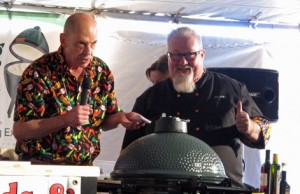 Over the years, our BBQ-fanatic readers have asked us hundreds of BBQ and grilling questions. With the assistance of the famous Ray Lampe, aka “Dr. BBQ,” we have answered them and placed them in a searchable database here. If you want a better idea of what you’ll find there, here’s a quick list of some of the issues he’s addressed for us at the SuperSite.
Over the years, our BBQ-fanatic readers have asked us hundreds of BBQ and grilling questions. With the assistance of the famous Ray Lampe, aka “Dr. BBQ,” we have answered them and placed them in a searchable database here. If you want a better idea of what you’ll find there, here’s a quick list of some of the issues he’s addressed for us at the SuperSite.
How to Garnish
Hi Ray,
I have a question about how to garnish my turn in box, I’m doing my first competition that requires it.I will be competiting at the Plant City PIG JAM . OK how do I go about doing my tray , do I put in the garnish first then the meat or put meat in first then garnish? Any help is good help, and hope to see you there so i can meet you in persons. THANK YOU for your time.
David,
Bogies Begg’n BBQ
Hi David,
Well since this contest is sanctioned by The Kansas City BBQ Society (KCBS) the only legal garnishes are leaves of green lettuce, parsley, and cilantro. The old school way was to lay in a bed of green leaf lettuce with the nice ruffle framing the box. Then add a whole lot of meat and then garnish with parsley. Forget about the cilantro as it would impart a taste that would be risky.
But in recent years the trend has become boxes that are a thick bed of parsley filled in to look almost like a golf green. Then the meat is laid on top making a beautiful presentation of the pieces. The downside I see to the parsley boxes is the effort involved in finding a lot of really nice parsley, and the labor involved in placing all those little pieces in the box. I always find that the bed of parsley limits the amount of food I can put in the box as well so I usually use a combination of parsley boxes for my chicken and brisket and lettuce boxes for my ribs and pork.
Dr. BBQ
Smoking
Q: Hi Dr. BBQ,
Love your site. I am thinking about entering the catering business. I know that many operators, restaurant and catering, have different methods of preparing ribs and brisket for large numbers of people. Is there a common method, especially taking into consideration that properly cooking one piece of meat can take an hour or two, not to mention smoking the meat for hours before? Thanks!
–Michael
A: Hello Michael:
Most BBQ caterers smoke the meat well in advance of the event and then sauce it and refrigerate it. They reheat it on portable grills just before serving.
–Dr. BBQ
Bottling Sauce
Q: Dr. BBQ,
I would like to bottle my BBQ sauce, mostly for friends and family. I have found information on canning but no information on bottling. I understand there has to be a certain Ph value for shelf life or citric acid may need to be added. Can the sauce be bottled in sterile containers without a canning process? Most of the sauces I see in the stores are in plastic containers and contain little or no preservatives. Any insight would prove helpful.
—Jon
A: Hello Jon:
Bottling and canning are the same process. Foods are heated to kill bacteria and then packed in sterile containers. Some manufacturers add acidity to retard bacterial growth after the product is opened. The full canning/bottling process is covered in Joy of Cooking, which should be fine for home use.
—Dr. BBQ
Complementary Meats
Q: Dear Dr. BBQ,
I find some gatherings just have too much of a good thing—too many choices. Are there certain pairings or meats you like to serve together?
–Rubicam
St. Petersburg, FL
A: Hi Rubicam,
I like to serve ribs and chicken together, just seems right and it’s a one-day cook. If it’s butts or briskets I usually serve just one of them unless I add sausage which is a good add-on anytime.
–Dr. BBQ
The Smoke Sweet Spot
Q: Hi Dr. BBQ,
Quite often when I barbecue baby back ribs, I find it hard to determine the fine line of just the right amount of smoke and too much smoke. I don’t mean “for my own personal taste,” I mean the difference between the nice, subtle smoke flavor and oversmoked, almost “dirty” taste. Is there any rule of thumb as to how much wood per rack of ribs and/or when to add the smoke wood to the established coals?
–Roger
Burlington, Ontario
A: Hi Roger,
Sorry, but there is no rule of thumb because every cooker is different. There are some basic rules that do apply to most cookers though:
- Always use well-seasoned wood.
- Some woods are stronger than others. Hickory can easily cause a problem. Apple is pretty mild.
- Ribs don”t have much meat on them compared to a roast so they will need less smoke. Start with a small amount of wood; if they”re undersmoked, you”ll still have a good dinner. Add a little more each time until you have just the right amount for your cooker.
–Dr. BBQ
Latest posts by Mark Masker (see all)
- 2024 Scovie Awards Call for Entries - 07/07/2023
- 2024 Scovie Awards Early Bird Special: 3 Days Left - 06/29/2023
- 2024 Scovie Awards Early Bird Deadline Looms - 06/25/2023







